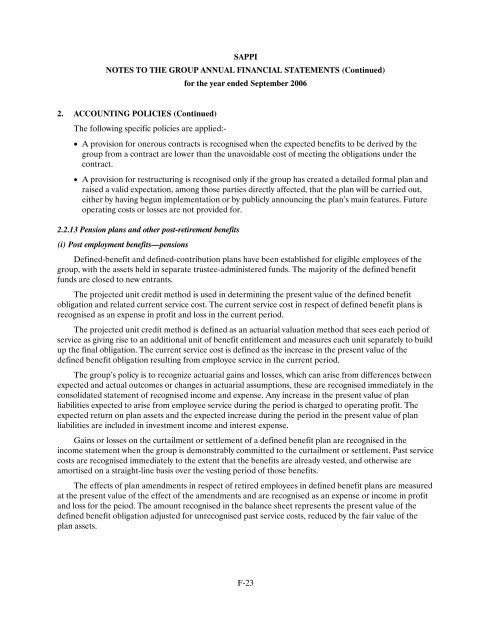Create successful ePaper yourself
Turn your PDF publications into a flip-book with our unique Google optimized e-Paper software.
SAPPI<br />
NOTES TO THE GROUP ANNUAL FINANCIAL STATEMENTS (Continued)<br />
2. ACCOUNTING POLICIES (Continued)<br />
The following specific policies are applied:-<br />
for the year ended September <strong><strong>20</strong>06</strong><br />
• A provision for onerous contracts is recognised when the expected benefits to be derived by the<br />
group from a contract are lower than the unavoidable cost of meeting the obligations under the<br />
contract.<br />
• A provision for restructuring is recognised only if the group has created a detailed formal plan and<br />
raised a valid expectation, among those parties directly affected, that the plan will be carried out,<br />
either by having begun implementation or by publicly announcing the plan’s main features. Future<br />
operating costs or losses are not provided for.<br />
2.2.13 Pension plans and other post-retirement benefits<br />
(i) Post employment benefits—pensions<br />
Defined-benefit and defined-contribution plans have been established for eligible employees of the<br />
group, with the assets held in separate trustee-administered funds. The majority of the defined benefit<br />
funds are closed to new entrants.<br />
The projected unit credit method is used in determining the present value of the defined benefit<br />
obligation and related current service cost. The current service cost in respect of defined benefit plans is<br />
recognised as an expense in profit and loss in the current period.<br />
The projected unit credit method is defined as an actuarial valuation method that sees each period of<br />
service as giving rise to an additional unit of benefit entitlement and measures each unit separately to build<br />
up the final obligation. The current service cost is defined as the increase in the present value of the<br />
defined benefit obligation resulting from employee service in the current period.<br />
The group’s policy is to recognize actuarial gains and losses, which can arise from differences between<br />
expected and actual outcomes or changes in actuarial assumptions, these are recognised immediately in the<br />
consolidated statement of recognised income and expense. Any increase in the present value of plan<br />
liabilities expected to arise from employee service during the period is charged to operating profit. The<br />
expected return on plan assets and the expected increase during the period in the present value of plan<br />
liabilities are included in investment income and interest expense.<br />
Gains or losses on the curtailment or settlement of a defined benefit plan are recognised in the<br />
income statement when the group is demonstrably committed to the curtailment or settlement. Past service<br />
costs are recognised immediately to the extent that the benefits are already vested, and otherwise are<br />
amortised on a straight-line basis over the vesting period of those benefits.<br />
The effects of plan amendments in respect of retired employees in defined benefit plans are measured<br />
at the present value of the effect of the amendments and are recognised as an expense or income in profit<br />
and loss for the peiod. The amount recognised in the balance sheet represents the present value of the<br />
defined benefit obligation adjusted for unrecognised past service costs, reduced by the fair value of the<br />
plan assets.<br />
F-23
















